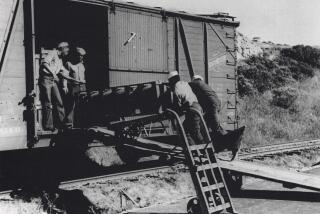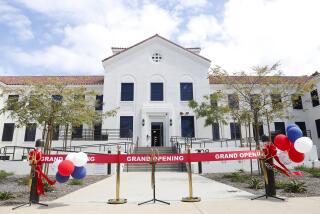After 40 Years, Merchant Marines Win Veteran Status : Finally--a ‘Flag and a Headstone’
WASHINGTON — When Herbert Iske returned to California after nine grueling months in the Pacific theater in World War II, he assumed the veterans parades and salutes and bands were meant for him too.
He was wrong: As a member of the U.S. merchant marine, Iske soon discovered that, in the eyes of his country, he was not a “veteran” of the war at all. Frustrated, disgusted, humiliated, he tore from his lapel the small gold eagle’s pin--the “ruptured duck” then worn proudly by veterans--and tossed it away in a drawer.
Last week, the 65-year-old Iske went looking for the duck pin again--with a newfound pride and recognition to guide him.
The Defense Department, yielding to pressure from a federal court ruling, responded earlier this month to four decades of appeals from World War II oceangoing merchant marines and granted them veterans’ status.
Under the decision, Iske and thousands of others like him who fought in World War II--and saw their fellow merchant sailors die in it at a higher rate than either Army or Navy forces--are now eligible for full veterans’ benefits.
Negligible Importance
The tangible dividends may prove of negligible importance to many of the surviving World War II seamen, who by some estimates number as many as 90,000. “For the most part,” said Air Force Brig. Gen. Edward N. Giddings, who is in charge of reviewing claims of veterans’ status, the eligible merchant seamen “will only get a flag and a headstone.”
But for many men who see themselves as the Vietnam veterans of a prior generation--unlauded, unrecognized, even maligned as somehow less worthy than their traditional military counterparts--that itself is enough.
“I can’t even begin to say how many of these men have told me: ‘When I die, all I want is for my widow to be handed the American flag,’ ” says Washington lawyer Joan C. McAvoy, who has taken up the merchants’ case for the last eight years. “Theirs is a forgotten chapter . . . (but) they can now stand up and be counted. This is not a losing cause.”
Several World War II merchant sailors, struggling since the close of the war to right a historical record that they say has been distorted by ignorance, called the decision long overdue--too long in many cases.
“This is sort of a sad victory--too little, too late” for the thousands of men who died before ever gaining recognition, said Joseph B. Vernick of North Hollywood, himself a merchant sailor who was a Japanese prisoner of war for more than three years in the Philippines. “A buddy of mine died about two years ago, broken-hearted because he couldn’t get veteran’s status.”
‘We Were Orphans’
For Vernick, the Jan. 20 decision on the merchant marine offers, most important, a place in the sun for a group that always “felt we were orphans, looked down upon.” But he also hopes his new status may gain him some compensation to alleviate medical problems that have plagued him since the war.
Returning from the Philippines badly injured physically and mentally, drained to 117 pounds from his normal 180, Vernick says he paid his medical bills himself--$8,000 for reconstructive surgery alone. The only thanks he got from the U.S. government, he recalls bitterly, was interrogation by the FBI as a reputed draft-dodger.
During World War II, as Vernick learned the hard way, the merchant marine played much more than its traditional commercial role. President Franklin D. Roosevelt, in creating the War Shipping Administration, made most of the 250,000 merchant sailors into U.S. government employees and pressed them into combat-type duty.
Venturing into some of the war’s most dangerous waters, the merchant marines were armed and trained in military maneuvers. Their ships carried mostly fuel, ammunition and other supplies for the fighting troops--making them frequent targets of enemy forces.
The merchant sailors’ vital and undisputed role in the war effort was hailed by presidents, generals and admirals alike. Roosevelt pushed for veterans’ benefits for them. Time and again the seamen returned to face intense perils, Roosevelt declared, “because they realized that the lifelines to our battle fronts would be broken if they did not carry out their vital part in this global war.”
But veterans’ groups such as the American Legion opposed veterans’ status for the merchant marine. “The American Legion has always jealously guarded the definition of the term ‘veteran,’ ” said John Sommer, the group’s director of veterans’ affairs. In the case of merchant sailors, he said, “their service, however hazardous, was not military.”
Defense Department officials contended for years that the merchant sailors did not meet its strict criteria for new veterans’ groups--criteria on training, discipline and organization.
The Air Force, responsible for making the decision on veterans’ status, has used these criteria in granting veterans’ status to 14 other groups, including the Women’s Army Auxiliary Corps (WAACs) and the Male Civilian Ferry Corps, under the 1977 GI Bill Improvement Act.
It was only under pressure from U.S. District Judge Louis F. Oberdorfer--who ruled that the Air Force had acted “arbitrarily and capriciously” in denying veterans’ status for the merchant marines--that the department officials, in the words of spokesman Capt. Chris Canfield, “reinterpreted our decision.”
Unfavorable Stereotypes
Oberdorfer, in ruling in a suit brought by World War II merchant sailors, rejected the unfavorable stereotypes that have stuck with them for years.
The merchant seamen were often seen, for example, as “draft dodgers” who sought to avoid “real combat.”
In fact, draft boards were instructed to seek out enlistees with maritime experience and refer them to the understaffed merchant marines for duty. Such was the case with Kenneth Sawyer of Houston who, assigned to the Army, was told by a sergeant that his seafaring experience could help the merchant marines.
“I heard that ships were going down each night and each day,” he said in a court affidavit. “I skipped my supper that day . . . and walked five miles across the field to enlist.”
As for the danger of their duty, Judge Oberdorfer found that their service was “not without cost.” Almost three of every 100 merchant seamen in the U.S. Maritime Service were killed, placing the group in a virtual tie with the Marines for the highest casualty rate in the war. In all, at least 5,662 merchant seamen--and several thousand more by some estimates--were killed, thousands more were injured and more than 700 of their ships were sunk.
World War II veterans also grumbled that the merchant marines were paid more than themselves and, the story goes, reaped overtime for working long hours. But Oberdorfer, addressing “this misconception,” cited several studies, including one by the Navy itself, that indicate the merchant seamen were paid about the same as their military counterparts.
Critics further complained that merchant sailors were not “regular army” in their protocol--”a different breed of cat,” as one congressional aide put it--because they did not take oaths of duty, wear uniforms or undergo military discipline. But several merchant marines said in recent interviews that they were in fact bound to duty by sworn allegiance and did wear uniforms regularly. As for discipline, they point to their 111 fellow merchant sailors who were court-martialed by 1943 for dereliction.
Hearing a top Navy official state some of these distortions publicly, merchant marine Stanley E. Gorski of Racine, Wis., decided to do something about it. He wrote to the official, Special Asst. Secretary Joseph K. Taussig Jr.: “I am appalled and saddened at how little the general public knows of who we were, what we were and what we achieved during those terrible trying days.”
‘Great Respect’
He received this telling response from Taussig: “ . . . (My) remarks were based on ignorant and very persistent faulty information. . . . I have now been properly educated as to the true facts, and assure you that should an occasion arise in the future to salute the Merchant Marine of WWII, I will do so with great respect.”
Herbert Iske looks forward to that respect. Scrounging through four decades of dust and battered feelings, he found his “ruptured duck” lapel pin the other day. But once uncovered, the tiny emblem paled in comparison to what it represented for him: “Finally, after 43 years, somebody said, ‘You’re a veteran.’ ”
More to Read
Sign up for Essential California
The most important California stories and recommendations in your inbox every morning.
You may occasionally receive promotional content from the Los Angeles Times.










